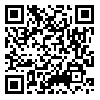

 , Mohammad Reza Mohammadi
, Mohammad Reza Mohammadi 

 2, Mohammad Ali Vakili3
2, Mohammad Ali Vakili3 

 , Asieh Sadat Baniaghil4
, Asieh Sadat Baniaghil4 

 , Maryam Ghelichli5
, Maryam Ghelichli5 

 , Mohammad Javad Najafi6
, Mohammad Javad Najafi6 

 , Atousa Mortazavi Milani6
, Atousa Mortazavi Milani6 

 , Amir Hossein Ghadirian6
, Amir Hossein Ghadirian6 

 , Fatemeh Shahrokhi6
, Fatemeh Shahrokhi6 

 , Hasan Khorshah7
, Hasan Khorshah7 

 , Sepide Sadat Hosseini8
, Sepide Sadat Hosseini8 


2- Dept. of Neurosurgery, School of Medicine, 5Azar Hospital, Golestan University of Medical Sciences, Gorgan, Iran ,
3- Dept. of Biostatistics and Epidemiology, School of Medicine, Golestan University of Medical Sciences, Gorgan, Iran
4- Dept. of Midwifery, School of Nursing and Midwifery, Golestan University of Medical Sciences, Gorgan, Iran
5- Dept. of Oral and Maxillofacial Pathology, School of Dentistry, Golestan University of Medical Sciences, Gorgan, Iran
6- School of Medicine, 5Azar Hospital, Golestan University of Medical Sciences, Gorgan, Iran
7- Dept.of Statistics, 5Azar Hospital, Golestan University of Medical Sciences, Gorgan, Iran
8- Dept.of Education, 5Azar Hospital, Golestan University of Medical Sciences, Gorgan, Iran
Background and Objective: COVID-19 was first seen in Wuhan-China in December 2019, and became a widely- spreadepidemic and caused a terrifying life-threatening problem in most societies of the world. In Iran, a declaration was made on January 20, 2020, and all health systems were alerted of the disease threats.
Materials and Methods: We collected all chest CT scans of 200 cases diagnosed as COVID-19 who died in 22 hospitals of Golestan Province, Iran. All data were collected in a designed checklist, then statistical evaluation was made using descriptive analysis and Chi-Square test.
Results: The most frequent complaints in patients were dyspnea (38.5%), fever(15%), and dry cough (13%) . Hypertension (22.5%), Heart disease (18.5%), and diabetes (15%) were present as underlying diseases. CT scan findings showed Ground Glass Opacity (96%), consolidation (44%), pleural effusion (26.5%), crazy paving (15%), and cardiomegaly (15.5%).
Conclusion: Based on this study, hypertension as an underlying disease was significantly related to Highly Suggestive CT scans. No relation was found between cardiomegaly and death under 48 hours. Our findings Showed Ground Glass Opacity (GGO) in 192 (96%), consolidation in 88 (44%), crazy paving in 30 (15%), cardiomegaly in 30 (15%), and pleural effusion in 53 (26.5%) cases.
✅ Based on this study, hypertension as an underlying disease was significantly related to Highly Suggestive CT scans. No relation was found between cardiomegaly and death under 48 hours. Our findings Showed Ground Glass Opacity (GGO) in 192 (96%), consolidation in 88 (44%), crazy paving in 30 (15%), cardiomegaly in 30 (15%), and pleural effusion in 53 (26.5%) cases.
Received: 2021/04/13 | Accepted: 2021/10/25 | Published: 2022/04/1
| Rights and permissions | |
 |
This work is licensed under a Creative Commons Attribution-NonCommercial 4.0 International License. |

